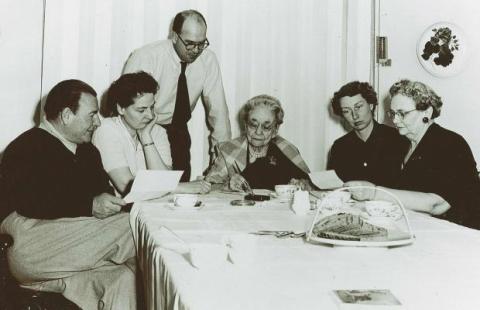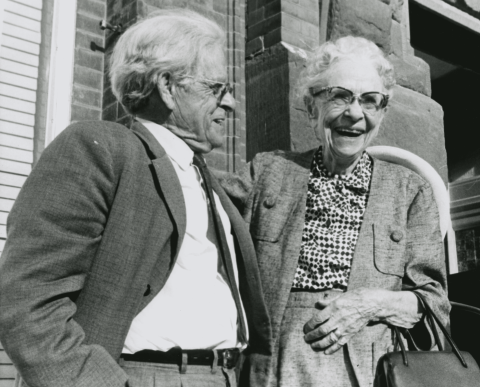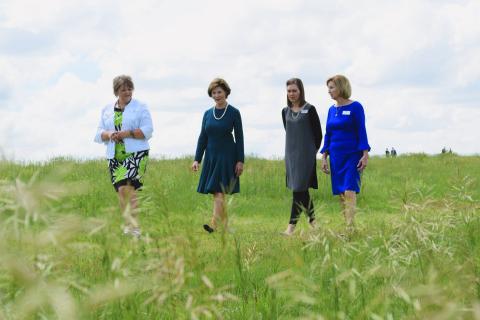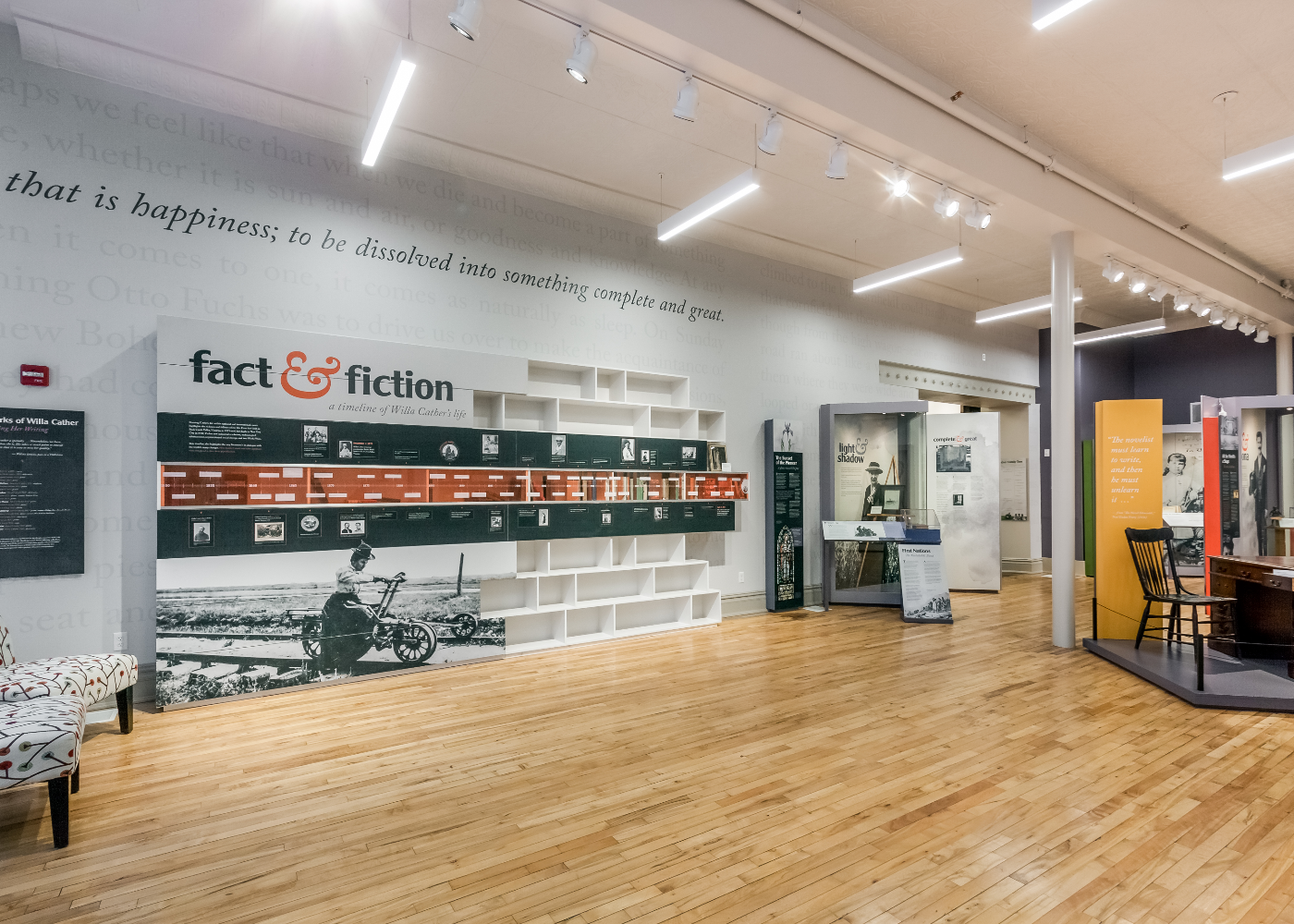
Organization History
The Willa Cather Foundation (WCF) was founded in 1955 by a group of local citizens led by Mildred R. Bennett, the first biographer of Cather. Upon moving to Red Cloud shortly after Cather’s death, Bennett became fascinated by people, events, and historic sites in and around Red Cloud and Webster County that had been intertwined with Cather’s fictional worlds. Bennett’s 1951 biography The World of Willa Cather is still widely used by scholars as a valuable source work for Cather’s early years. In the early 1950s, Bennett gathered a small group of Red Cloud citizens, interested individuals, and scholars from throughout Nebraska to form the WCF’s Board of Governors. The group recognized Cather’s importance to American literature and Red Cloud’s unique potential to become a living museum, reflecting the settings for six of Cather’s twelve novels and many of her short stories.
For the first twenty-five years of operations, the Foundation amassed a large museum collection and acquired and restored historic buildings important to the life and works of Cather. By the mid-1970s, it had acquired and restored six sites, including Cather’s childhood home, a National Historic Landmark; the Farmers and Merchants Bank, erected by Silas Garber, prototype for Captain Forrester in A Lost Lady the Burlington Depot, which appears throughout Cather’s work; the St. Juliana Catholic Church, of the novel My Ántonia the Grace Episcopal Church, which houses a pair of stained-glass windows donated by Cather in memory of her parents; and the Pavelka Farmstead, the rural setting for the final scenes in My Ántonia. A pivotal event was the 1962 dedication of the Farmers and Merchants Bank as the Willa Cather Museum, at which poet John G. Neihardt noted:
In dedicating this Memorial to Willa Cather, great woman, great literary artist, who once was one of ours and now belongs to the great world and to time, it is well that we should emphasize for ourselves the significance of what we are doing here today.
Just as surely, it is for us, the living, and for the living who shall follow us, generation after generation, that we set this Willa Cather Memorial against the flowing years, last we forget the precious heritage that is ours through her.
Here where the girl first dreamed the dreams that led to greatness; here where so many of the people of the living world she built in story moved briefly in the flesh; here now, in humility and gratitude, we dedicate this reminder of our debt to her.

An early turning point in the history of the Foundation came in 1978, when its Cather collections and historic sites were transferred to the State of Nebraska. This action was intended to ensure long-term preservation of the assets while the Foundation shifted focus toward educational outreach and programming. Following the transfer, the sites became collectively known as the Willa Cather State Historic Sites and the collection became known as the Willa Cather Pioneer Memorial Collection. The Foundation later assumed responsibility for day-to-day management and operation of the Willa Cather State Historic Sites in 1994 through a contractual arrangement with History Nebraska.
Preservation work continued in subsequent decades when the Foundation accepted gifts of the J.L Miner House, a primary setting in My Ántonia, as well as the First Baptist Church, which Cather attended as a child. In 2003, the Foundation completed a $1.7 million restoration of the Red Cloud Opera House, a downtown site on the National Register of Historic Places. A $1.2 million endowment campaign followed to successfully match a challenge grant from the National Endowment for the Humanities in order to significantly expand operations and programs. In her youth, Cather attended events, delivered her graduation address, and appeared in productions at the Opera House. Today, the space continues to operate as one of the few arts venues in the region that provides regular programs and art exhibits to residents in an economically depressed and underserved area.
After the Nature Conservancy gifted the Willa Cather Memorial Prairie in 2006, the Foundation embarked on a different kind of restoration. Soon after the acquisition, the Foundation worked to restore the 612-acre tract of native grassland to its pre-1900 conditions, established hiking trails, and developed viewing guides. It remains a key element of interpreting Cather’s prairie-based works.
The Foundation acquired the Cather Second Home in 2011. Cather’s parents owned this site, and it is where Cather stayed during her extended adulthood visits to Red Cloud. In addition, the structure is the setting in one of her final stories, “The Best Years.” Following restoration, the property began operating as a much-needed overnight and extended-stay guesthouse for Red Cloud visitors.

The National Willa Cather Center (NWCC) was born after a $7 million campaign to restore and adaptively reuse the historic Moon Block in downtown Red Cloud. Soon after its dedication by Former First Lady Laura Bush in 2017, the National Willa Cather Center became an award-winning archive and museum dedicated to promoting Cather’s legacy. In addition to preserving and breathing new life into nearly an entire block of downtown Red Cloud, the restoration provided a climate-controlled archive, study center, classroom, and expanded offices, bookstore, exhibit areas, and a greenroom for the adjacent Opera House. The mixed-use building also houses loft apartments and street-level retail spaces.
In 2018, the Nebraska Legislature unanimously passed LB 379, a bill that allowed History Nebraska to transfer ownership of their Willa Cather State Historic Sites to the Foundation in order to ensure local control, restoration, and long-term preservation of these historic properties. The Foundation then accepted ownership of the Willa Cather State Historic Sites and the Willa Cather Pioneer Memorial (WCPM) Collection — comprised of approximately 8,000 documents and artifacts related to the life, times, and works of Cather.
Acceptance of the 2019 transfer of the Willa Cather Historic Sites and WCPM Collection ushered in a new era for the Foundation, and provided an opportunity not only to restore the sites, but to reimagine the entire visitor experience with an overarching goal of improving and building upon these nationally significant cultural assets for educational purposes and community economic development through tourism. The transfer also necessitated a reimagining of the appropriate staffing model that included adding new education and preservation staff positions, as well as launching an integrated fundraising campaign, known as the Campaign for the Future, to address capital improvements, program, staffing, and endowment needs, as well as invest in the development of a downtown boutique hotel in Red Cloud to enhance visitor amenities.
The Campaign for the Future exceeded its initial fundraising goals and provided funds to restore four historic sites, add education and preservation staff, expand educational outreach, and establish an endowment to support long-term preservation of the historic sites. Campaign for the Future: Chapter Two is focused on completing capital fundraising for the rehabilitation of the Willa Cather Childhood Home and the Potter Block into Hotel Garber. The campaign also aims to support the addition of collections and program staff, conservation of artifacts, and reinterpretation of the historic sites to create more immersive destinations to explore Cather's life, writing, and times.

